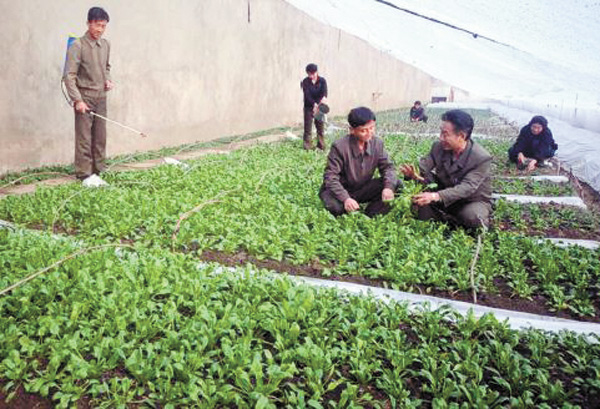In North Korea, greenhouses help people get by

Workers grow vegetables in a greenhouse set up by the Unjong Vegetable Collective Farm in Kanggye, Jagang Province. Reported in the Rodong Sinmun
North Korean leader Kim Jong-un praised the construction of greenhouses in December, when he made a field guidance trip to the June 8th Farm.
“I feel relieved from my fatigue. I feel good. I would not like to leave this greenhouse,” Kim was quoted as saying in the Rodong Sinmun, the official newspaper of the country’s Workers’ Party.
The newspaper reported that Kim felt proud that the North Korean people could eat fresh vegetables, which are grown in greenhouses even during the harsh winters. The young leader’s love for these nurseries is special - an affection he previously conveyed in June when he made a visit to the Jangchon Vegetable Collective Farm in Sadong District in Pyongyang.
“I encourage our people to build more greenhouses in order to enable our people to eat fresh vegetables, even in the cold winter season,” Kim said at the farm.
North Koreans grow vegetables, like napa cabbage, crown daisy, lettuce, spinach, radishes, squash, cucumbers and tomatoes, in these facilities. Napa cabbages are the most common.
The produce varies, as well, according to the temperature inside each greenhouse. In temperatures above 10 degrees Celsius, plants that bear fruit, such as tomatoes, are cultivated. If the temperature maintained is between 5 degrees and 7 degrees Celsius, napa cabbages are the staple. Crown daisy can be cultivated at 2 to 5 degrees Celsius, and spinach at below 2 degrees Celsius.
The key to greenhouse culture is being able to maintain warm temperatures inside. North Korean households suffer from chronic fuel and heating shortages, so the idea of heating a greenhouse with fuel is nearly inconceivable. Instead, they use solar heat. To do so, North Koreans build up a thermal storage wall on one side of the greenhouse with heat-absorbing stones that are colored with dark paint to make them more conductive. However, there is a downside to using a thermal storage wall: Because the wall is stationary once erected, it cannot absorb solar heat throughout the day as the sun moves.
After North Koreans acquired knowledge about greenhouse farming from other countries, they began to build round greenhouses that are shaped like cylinders cut in half, which can receive and store more solar heat.
And a few South Korean civic groups and companies have shown interest in modernizing greenhouses in North Korea. One company has attempted to provide red clay bricks, which are more effective for preserving heat than stones or thermal walls.
And a local civic group is planning to send South Korean plastics to the North. Chinese plastics decrease light transmission and have a lower resistance to snow and rain than their South Korean counterparts.
BY Ko Soo-suk [ko.soosuk@joongang.co.kr]










with the Korea JoongAng Daily
To write comments, please log in to one of the accounts.
Standards Board Policy (0/250자)